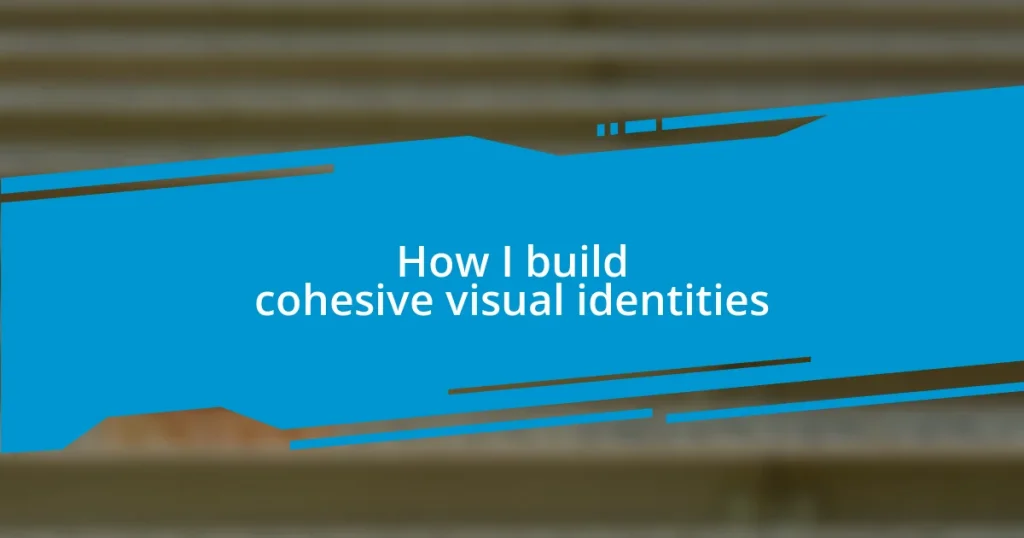Key takeaways:
- Visual identity elements, such as colors and typography, significantly influence brand perception and emotional connection with the audience.
- Defining a brand’s purpose is essential for creating a cohesive visual identity that resonates with the target audience and fosters deeper connections.
- Implementing consistent branding across various platforms enhances trust and credibility, while audience feedback can refine and improve the brand’s identity.
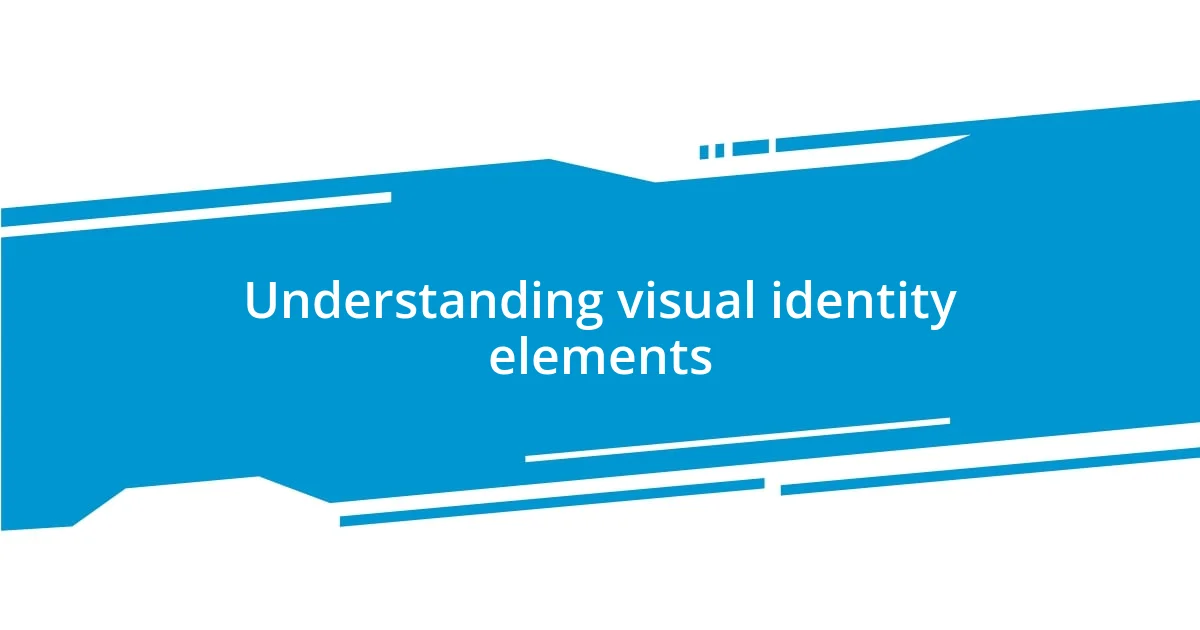
Understanding visual identity elements
Visual identity elements are the building blocks of a brand’s personality. I remember when I was first tasked with creating a brand identity for a small local business. I learned through trial and error that colors, typography, and logos need to resonate with the audience. Each choice feels personal; it’s almost like dressing a friend for an important event. Have you ever felt that connection when you see a brand’s color that just clicks?
Take color, for example. I used to think it was just about aesthetics, but I’ve come to realize that colors evoke emotions and influence perceptions. In my experience, choosing a fresh, vibrant palette made a noticeable impact on how customers perceived a brand’s energy. Imagine walking into a café painted in warm yellows and oranges versus one in cool blues – both places evoke entirely different feelings.
Typography also plays a crucial role, representing the tone and character of a brand. I once worked with a tech company that opted for a modern sans-serif font, and it transformed how people viewed their approachability. This change got me thinking—how many brands miss opportunities simply because their typeface doesn’t reflect their essence? Aligning visual elements ensures that every aspect communicates a cohesive message to the audience.

Defining your brand’s purpose
Defining your brand’s purpose is the foundation for everything that follows in your visual identity. It’s not just a statement; it’s a compass guiding your choices. I recall a project where I worked with a nonprofit aimed at environmental conservation. Their purpose wasn’t just to promote sustainability; it was about inspiring action and fostering community. Understanding this deeper mission allowed us to create visuals that were not only beautiful but also imbued with meaning and urgency.
To clarify your brand’s purpose, consider these guiding points:
– Mission Statement: What is your brand’s core reason for existing beyond profit?
– Target Audience: Who do you serve, and what do they value?
– Unique Value Proposition: What sets your brand apart from competitors?
– Emotional Impact: What feelings do you want your audience to associate with your brand?
– Long-Term Vision: Where do you see your brand in the next five to ten years?
By distilling these elements, I found that brands not only enjoyed a clearer identity but also a stronger connection with their audience. It’s fascinating how, in honing my understanding of purpose, I’ve helped brands resonate more profoundly with their followers, turning customers into passionate advocates.
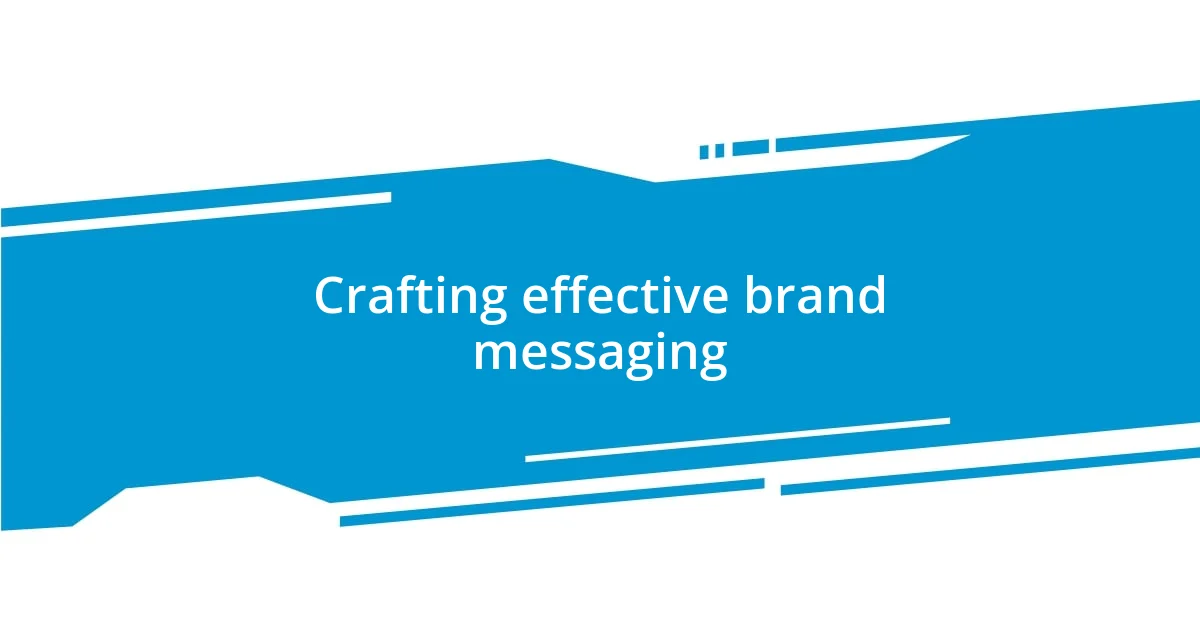
Crafting effective brand messaging
Crafting effective brand messaging goes beyond mere words; it’s about creating a narrative that connects with people on an emotional level. I remember the moment when I crafted a tagline for a health food brand—it was like finding the perfect key for a locked door. The phrase “Fuel Your Journey” struck a chord. It encapsulated their mission while inviting consumers to see themselves in the message. Have you ever had that lightbulb moment where everything just clicks? That’s the power of effective messaging.
In my experience, the tone of voice you use can dramatically influence how your audience perceives your brand. For instance, I once collaborated with a youthful tech startup that utilized a casual, conversational tone in their communications. This approach made them appear relatable and approachable, contrasting sharply with the stiff, corporate jargon of their competitors. How often do we overlook how a simple change in tone can redefine a brand’s identity? It’s essential to align this voice consistently across all channels to truly resonate.
Effective messaging also involves understanding the nuances of your audience’s needs. I once asked customers what drew them to a specific brand, and the answers were enlightening. People often choose brands they feel understand them. By integrating feedback and insights into messaging, brands can foster deeper connections. When you tailor your communication, it’s like having a heartfelt conversation with someone who truly “gets” you.
| Messaging Element | Significance |
|---|---|
| Clarity | Ensures your message is easily understood |
| Consistency | Builds trust across all platforms |
| Emotion | Creates a memorable connection with the audience |
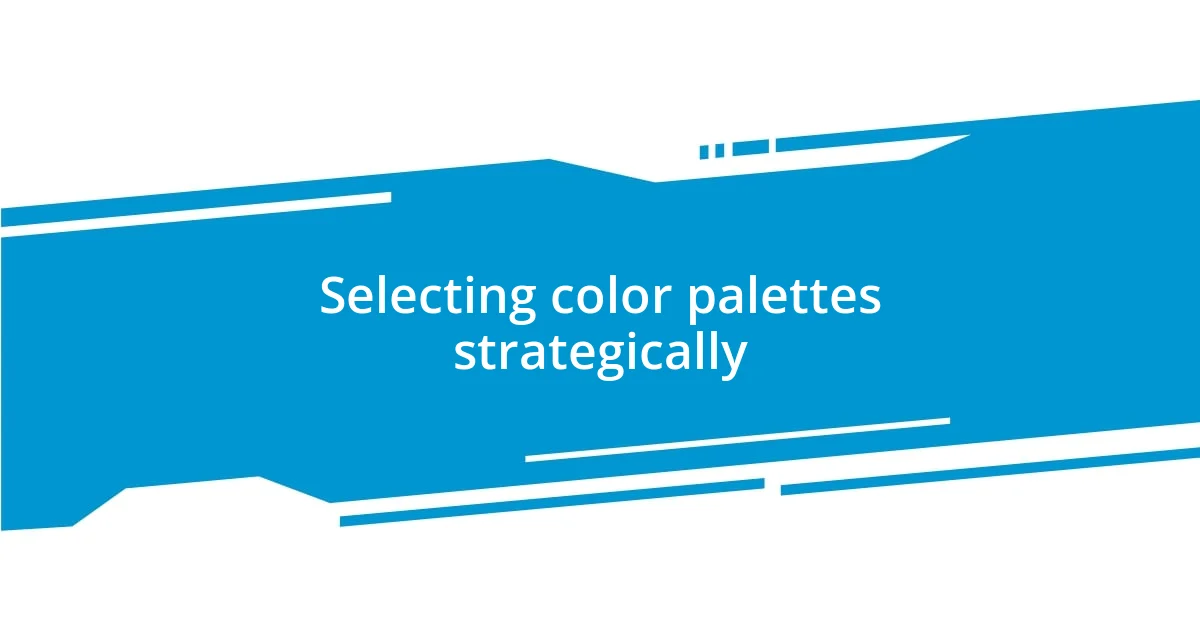
Selecting color palettes strategically
Choosing the right color palette is more than just picking pretty hues; it’s about evoking emotion and aligning with your brand’s identity. I remember when I worked on a campaign for a wellness retreat. We chose soft, earthy colors—greens and browns—to convey tranquility and connection with nature. Have you ever noticed how certain colors can instantly change your mood? That’s the power of color psychology at work.
In my experience, it’s crucial to consider your target audience when selecting colors. I once collaborated with a tech brand aiming at Gen Z, and we opted for vibrant, bold colors that felt energetic and fresh. I realized how intuitive this choice was during focus groups—the feedback was overwhelmingly positive, reinforcing that colors resonate differently with various demographics. Isn’t it fascinating how a splash of color can create a sense of belonging?
Lastly, when curating a color palette, it’s essential to think about versatility across different mediums. For instance, while designing for an online brand, I learned that colors often look different on screen compared to printed materials. I meticulously tested hues in various formats, ensuring consistency and impact. Have you tried this approach in your projects? Seeing the colors in action makes a world of difference!
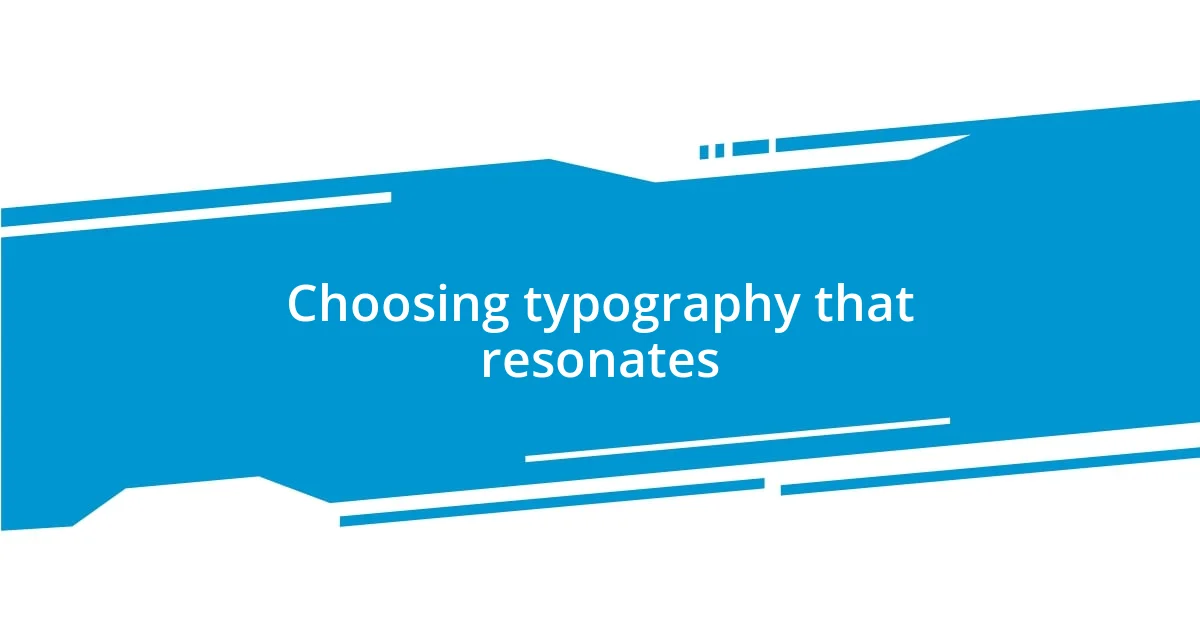
Choosing typography that resonates
Choosing the right typography can transform a brand’s message and create lasting impressions. I recall a project where we rebranded a creative agency, and after exploring various typefaces, we landed on a sleek, modern sans-serif font. It didn’t just look good; it embodied the agency’s innovative spirit. Have you ever seen a font that felt like it perfectly matched the vibe of a brand? That’s the kind of resonance I strive for.
When selecting typography, aligning it with your brand’s personality is key. For example, I once worked with a luxury jewelry brand that required a classic serif font to evoke elegance and tradition. It was fascinating to observe how changing the font changed the overall perception of the brand. Isn’t it interesting how a simple font switch can communicate sophistication?
I find it equally important to consider readability across different platforms. During a campaign for an e-commerce site, I chose a clean, straightforward typeface that ensured ease of reading on both desktop and mobile devices. It amazed me how a well-chosen font could improve user experience and even increase conversion rates. Have you thought about the impact typography can have on your audience’s journey? It’s clear to me thatwhen typography resonates well, it naturally guides the viewer’s eye and engages them effectively.
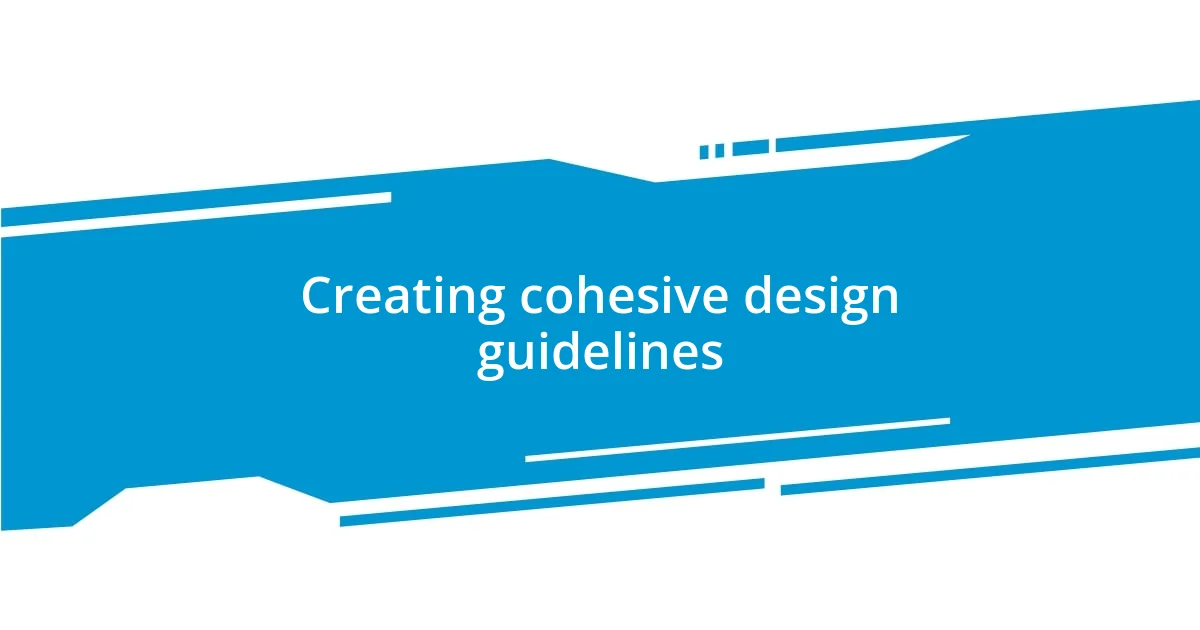
Creating cohesive design guidelines
Creating comprehensive design guidelines is all about establishing a clear and consistent voice for your brand. I vividly remember when I was developing guidelines for a non-profit organization; we focused on creating a unified look and feel. By incorporating simple rules around color usage, typography, and imagery, we empowered everyone on the team to represent the brand accurately. Isn’t it incredible how a well-documented guide can eliminate confusion and enhance collaboration?
In my experience, visual guidelines that include examples can make a significant difference. During a project for a lifestyle brand, I created a visual library featuring dos and don’ts. This approach not only inspired creativity but also provided clarity on how visual elements should be executed. It’s amazing how seeing a single concept illustrated can spark new ideas. Have you ever tried incorporating visuals in your design guidelines?
I also find it beneficial to revisit and refine these guidelines regularly. For instance, when I collaborated with a tech startup, we initially set strict rules. However, as their brand evolved, we recognized the need for flexibility. Adjustments to our guidelines allowed them to express their creativity while maintaining cohesion. Isn’t it refreshing to let your design grow with your brand? Balancing structure with adaptability is crucial for any successful visual identity.
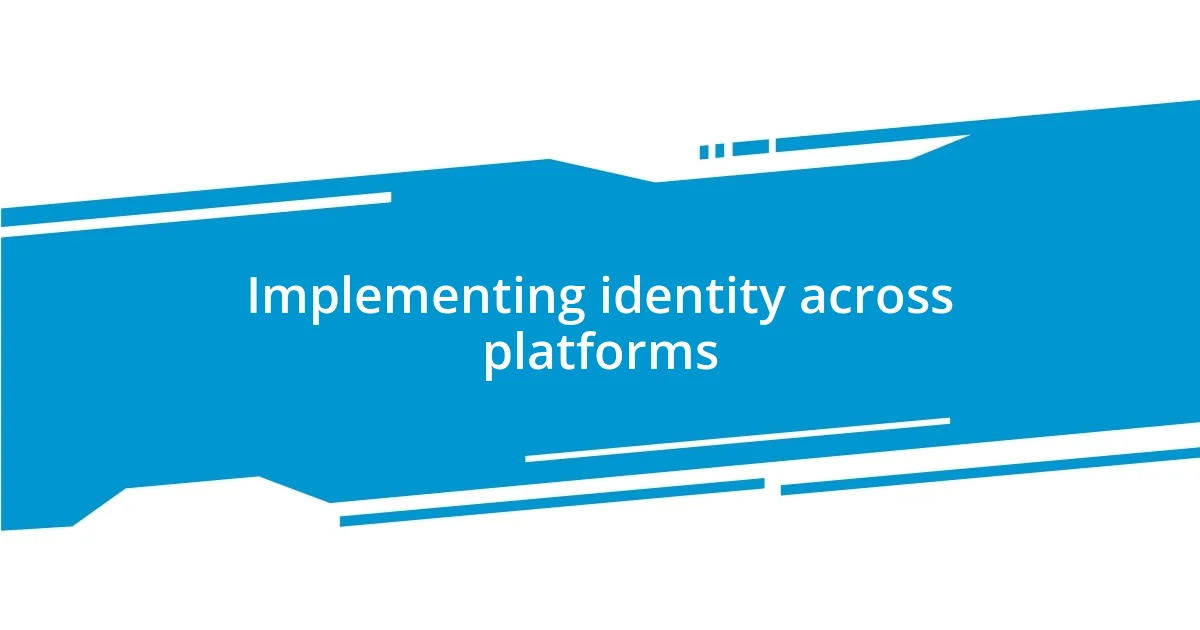
Implementing identity across platforms
Implementing a brand identity across various platforms requires a thoughtful approach to ensure that the core message remains intact. I remember launching a social media campaign for a vibrant lifestyle brand, where we carefully adapted the brand visuals for Instagram, Facebook, and Twitter. It was rewarding to see how a consistent color palette and imagery created a recognizable presence, even as we tailored the content for each platform. Have you ever considered how different formats might affect the perception of your brand?
Visual identity should not just be about aesthetics; it’s about creating an experience for the audience. For instance, while working on an email marketing strategy for a healthcare company, we focused on maintaining a calm and professional look across all communications. By using the same logo placement and color themes, we provided a sense of continuity that reassured recipients. I found it fascinating how a seamless visual journey can build trust—don’t you think cohesiveness is key in establishing credibility?
I also believe in the power of feedback during implementation. While collaborating with a fashion brand, we sought input from their audience on various visual elements across platforms. This engagement not only fostered community but also allowed us to refine our approach based on real insights. The result was a dynamic brand identity that resonated well with its followers. Have you ever engaged your audience in shaping your visual identity? It can truly be a game-changer in building a cohesive presence.










